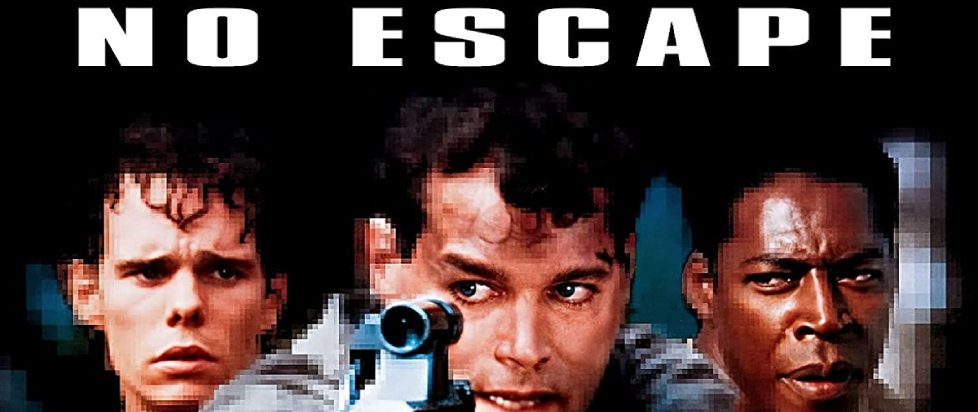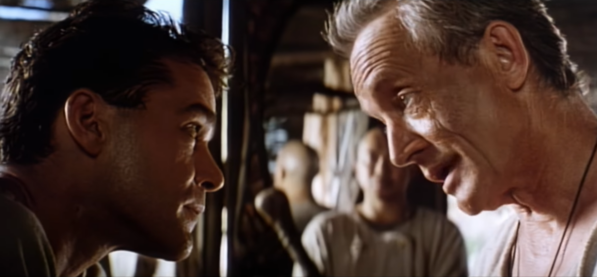
Not in the World: The Unlikely Precognition of No Escape (1994)
“In the year 2022, the international prison system is operated by private corporations. Criminals from all over the world are exploited at a profit. Prisons have become big business.”
No Escape is one of those movies that I used to rent from my local video store a lot when I was a kid. Less because it’s especially good and more because my local video store had it and it’s the kind of movie that I rented a lot. This and monster movies. That was my childhood.
That said, despite the fact that I have to have seen it all the way through at least a half-dozen times, I remembered basically nothing about this movie prior to sitting down with the new Blu-ray from Unearthed Films. Early on, I was hit with a bit of delightful serendipity. Watching this near the end of 2022, I was pleased to see that it was set in 2022, and the opening text crawl, which I reproduced in its entirety above, is actually pretty damned accurate.
It’d be tempting to say that it’s about the only thing the movie gets right about 2022 but, honestly, we see very little of the world in which this movie takes place. The only location we see besides the island prison that is the film’s main setting is a brief stopover at another, more high-tech prison, where Michael Lerner (Anguish) is the sadistic warden. It’s the first in a long line of recognizable faces that will dot the remainder of the proceedings.
Originally released in 1994, during that brief window of time when Ray Liotta could potentially open a movie like this, No Escape is a relatively early-career film from Martin Campbell, released a year before his big breakout with GoldenEye. As such, it’s not quite as ambitious as some of his other films, but you can see the potential that films like that one and his other dalliance with Bond, Casino Royale, would eventually exploit.
As I mentioned, besides Ray Liotta, this film features an impressive array of character actors. Lance Henriksen is here in a rare good guy role. Ernie Hudson plays the head of security in the encampment of the good guy prisoners. Kevin J. O’Connor is mostly around for comic relief, as usual. Stuart Wilson seems to be having a blast playing the movie’s big bad.

There is very little in the plot that you couldn’t guess from literally the film’s one-sentence premise. A court-martialed Navy SEAL type gets sent to a secret island prison after he kills his commanding officer and then escapes several other maximum security prisons. Once there, he becomes caught up in an ongoing conflict between the Insiders (good guy prisoners who live an idyllic communal lifestyle) and the Outsiders (bad guy prisoners who are basically the villains from any and every post-apocalyptic movie ever made).
Naturally, his presence both brings this conflict to a head and pretty much single-handedly resolves it. What makes No Escape work, to the extent that it does, is how little it centralizes the skillset that ostensibly is what makes our protagonist capable of succeeding where others have failed. It is as much timing and luck and events that are happening beyond either his awareness or control that make him the film’s “chosen one” as it is any innate qualities that he might possess.
What’s more, though Liotta’s character has the usual ‘90s action movie protagonist’s complete disdain for authority, his reasoning is more sound than most – during his military service, he was ordered to kill a village full of non-combatants, which he did. He then assassinated his commanding officer in order to try to draw attention to it when the slaughter was covered up. Makes it easy to see why he says things like, “I’m not a joiner anymore.”
In fact, to the extent that No Escape has anything more novel to say than “prisons are bad” – which they are, and it’s great when movies say so, but like “war is hell” it may be true but it’s also a bit of a cliché in pictures like this – it’s probably something to do with its many meditations on guilt, and what guilt should cost us.
Because it is a film that takes place entirely in prison – there aren’t even flashbacks to show us life in the “real world” – every single character in it is carrying some kind of burden of guilt, and most of the scenes in which characters form powerful bonds take place when they’re sharing that burden with one another, discussing (or disclosing) the sins that they have committed to bring them to this place. The film certainly has something to say about that guilt, and about how absolution isn’t necessarily the same thing as forgiveness. Even if it never says it particularly eloquently.

The most interesting moments in the film occupy its fringes. In an uncanny bit of precognition, Ray Liotta’s character killed his commanding officer due to events that took place in Benghazi in 2011. These are the kinds of things I didn’t notice when I watched this as a kid – in part because 2011 hadn’t happened yet back then. It’s also technically a Christmas movie.
Something else I didn’t notice is just as striking, but not as coincidental. There is a huge cast of extras in this movie. The Outsiders are supposed to number around 600 strong, and you see large groups of them numerous times. There are also several big battle sequences. And yet, because the film takes place entirely in a (presumably men’s) prison, there are no female characters. Not even a spouse or love interest that Ray Liotta’s character remembers in a flashback. Indeed, I can remember only one mention of a woman, in Lance Henriksen’s backstory. Making this one of the only movies I can think of to have not a single female character – and the other one that springs to mind only has about a dozen people in it.



